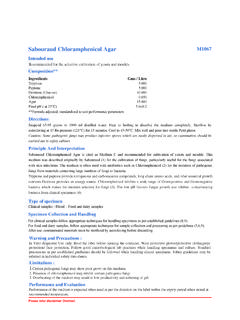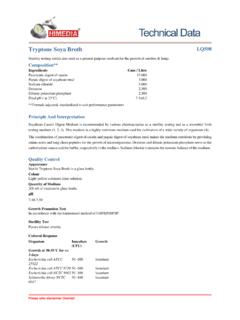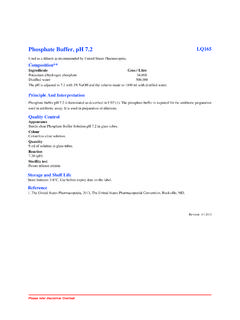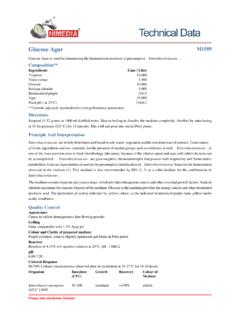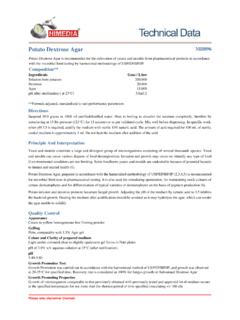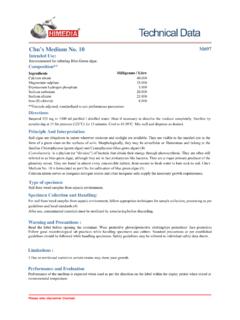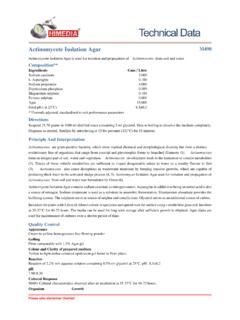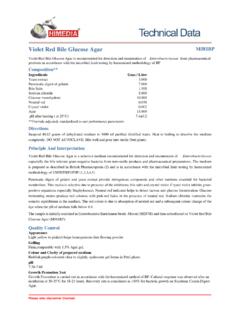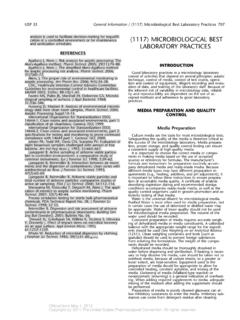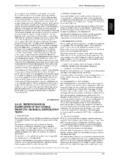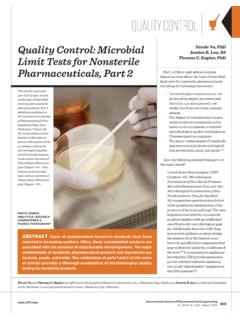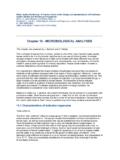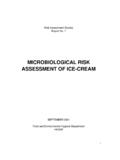Transcription of Chloramphenicol Yeast Glucose Agar - HiMedia Labs
1 Please refer disclaimer Yeast Glucose AgarM1008 Chloramphenicol Yeast Glucose agar is a selective medium recommended for selective enumeration of yeasts and moulds inmilk and milk **IngredientsGms / LitreYeast ( Glucose ) pH ( at 25 C) **Formula adjusted, standardized to suit performance parametersDirectionsSuspend 40 grams in 1000 ml distilled water. Heat to boiling to dissolve the medium completely. Sterilize by autoclaving at15 lbs pressure (121 C) for 15 minutes. Cool to 45-50 C. Mix well and pour into sterile Petri And InterpretationChloramphenicol Yeast Glucose agar is a selective medium recommended for isolation and enumeration of fungi-yeasts and moulds in milk and milk products (1, 2, 3).
2 Recently this medium has been recommended by ISO committee for the enumeration of yeasts and moulds (4). The medium contains Yeast extract, which provides nitrogenous nutrients and vitamin B complex. Dextrose( Glucose ) is the energy source. Chloramphenicol , a thermostable antibiotic, suppresses accompanying bacterial flora. This improves shelflife of the prepared medium and the prepared medium can be used over a period of at least 4 months (5).Technique: Take two sterile Petri plates and transfer 1 ml of sample (if liquid) or 1 ml of the initial suspension in case of other products.
3 Further take another two sterile plates and transfer 1 ml of 10-1 dilution to each sterile Petri plate or 1 ml of 10-2 dilution for other products. Repeat the procedure using further dilutions if necessary. Pour about 15 ml of Chloramphenicol Yeast Glucose agar (5) previously melted and maintained at 45 1 C. The time elapsing between the end of the preparation of the initial suspension and the moment when the medium is poured into the dishes shall not exceed 15 minutes. Carefully mix the inoculum with the medium and allow it to solidify.
4 Prepare control plate to check the sterility. Incubate the plates at 25 1 C. Count the colonies on each plate after 3, 4 and 5 days incubation. It is necessary to carry out a microscopic examination in order to distinguish, according to their morphology, the colonies of Yeast and moulds from colonies of is advisable to examine the plates at the end of three days for Yeast colonies, as they are likely to be overgrown by mouldgrowth. Make a separate count of Yeast colonies, which are characterized, as smooth, moist, elevated surface colonies.
5 Countmould colonies, which are recognized by their profused growth of hyphae. If only Yeast counts are required, add ofsterile sodium propionate solution to the medium at the time of preparation of plates to inhibit the growth of moulds (6).Intended UseType of specimen Dairy samples Specimen Collection and Handling: For Dairy samples, follow appropriate techniques for sample collection and processing as per guidelines (7). After use, contaminated materials must be sterilized by autoclaving before discarding. Warning and Precautions :In Vitro diagnostic Use only.
6 Read the label before opening the container. Wear protective gloves/protective clothing/eye protection/ face protection. Follow good microbiological lab practices while handling specimens and culture. Standard precautions as per established guidleines should be followed while handling clincal specimens. Saftey guidelines may be referred in individual safety data sheetsHiMedia LaboratoriesTechnical DataCultural ResponseM1008: Cultural characteristics observed after an incubation at 22-25 C for 2-5 (CFU)GrowthRecovery#Aspergillus brasiliensisATCC 1640450-100good-luxuriantCandida albicans ATCC10231 (00054*)50-100good-luxuriant>=50%Escheri chia coli ATCC25922 (00013*)>=10 inhibitedSaccharomyces cerevisiae ATCC 9763 (00058*)50-100good-luxuriantStaphylococc us aureus ATCC 25923 (00034*)
7 >=10 inhibited0%0%>=50%Quality ControlAppearanceCream to yellow homogeneous free flowing powderGellingFirm, comparable with agar and Clarity of prepared mediumYellow coloured, clear to slightly opalescent gel forms in Petri platesReactionReaction of w/v aqueous solution at 25 C. pH : :Due to variable nutritional requirements, some straind shoe poor growth on this and EvaluationPerformance of the medium is expected when used as per the direction on the label within the expiry period when stored at recommended and Shelf LifeStore between 10-30 C in a tightly closed container and the prepared medium at 2-8 C.
8 Use before expiry date on the label. On opening, product should be properly stored dry, after tightly capping the bottle inorder to prevent lump formation due to the hygroscopic nature of the product. Improper storage of the product may lead to lump formation. Store in dry ventilated area protected from extremes of temperature and sources of ignition Seal the container tightly after use. Use before expiry date on the performance is best if used within stated expiry period. User must ensure safe disposal by autoclaving and/or incineration of used or unusable preparations of this product.
9 Follow established laboratory procedures in disposing of infectious materials and material that comes into contact with clinical sample must be decontaminated and disposed of in accordance with current laboratory techniques (8,9). Disposal#Key: Formerly known as Aspergillus nigerKey : *Corresponding WDCM refer disclaimer LaboratoriesTechnical Data1. DIN Deutsches Institut fur Normung Reterenzverfahren DIN International Organization for Standardization (ISO), Draft ISO/DIS Internationaler Milchwirtschaftsverband: Internationaler IMV-Standard 94 International Organization for Standardization (ISO), 1987, Draft ISO/DIS Engel G.
10 , 1982, Milchwiss, 37 International Organization for Standardization (ISO), 1999, ISO 5403 : 03 / 2017 ReferenceHiMedia Laboratories Pvt. Ltd. A-516,Swastik Disha Business Park,Via Vadhani Ind. Est., LBS Marg, Mumbai-400086, India. Customer care No.: 022-61471919 Email: :User must ensure suitability of the product(s) in their application prior to use. Products conform solely to the information contained inthis and other related HiMedia publications. The information contained in this publication is based on our research and developmentwork and is to the best of our knowledge true and accurate.
